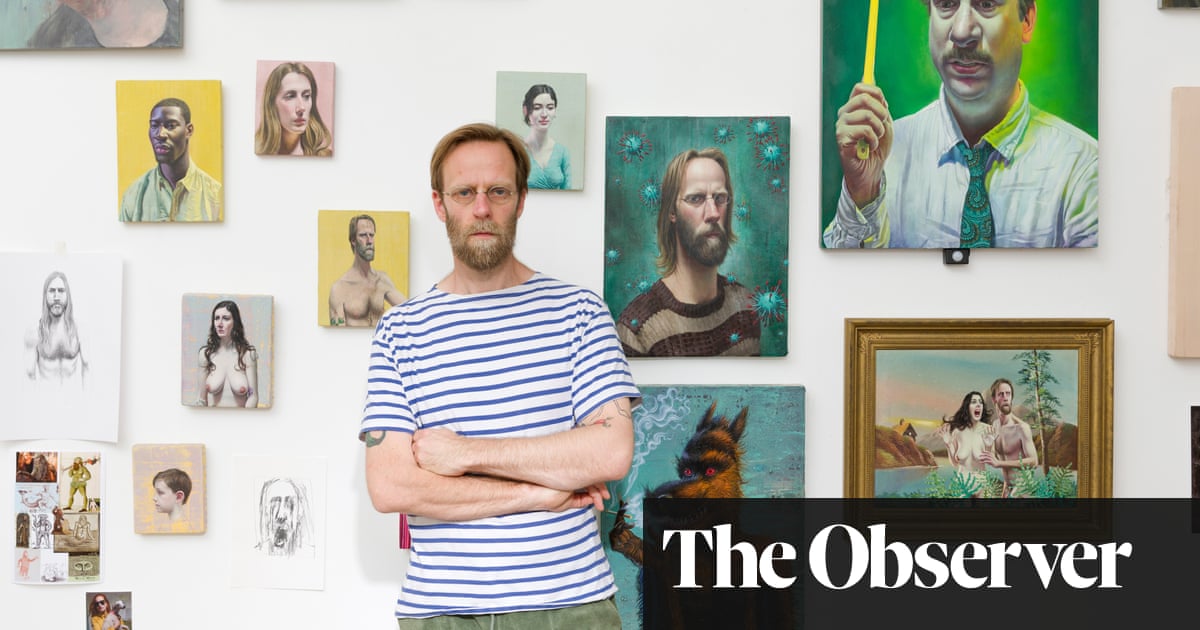
“I’m kind of just living on Pandora right now,” said James Cameron recently, as he tinkered with a remaster of his 2009 blockbuster Avatar, for rerelease in preparation for its sequel, Avatar: The Way of Water, in December. It’s the second instalment of a four-part franchise that includes the already-written Avatar three and four, due for release in the next decade, by which time the audience will have had ample opportunity to join Cameron on his fictional world.
That was always the dream behind the Avatar films: immersion in the world of Pandora, a habitable, extrasolar moon somewhere in the Alpha Centauri system whose every tree, plant, bush flower and blade of grass is rendered in every weather condition – rain, sun, mist – with the help of facial rigs, motion capture and key-frame CG animation. You “enter a world”, said Cameron. “You become fully immersed in it. You feel like it surrounds you and you become an inhabitant there … You go on that journey.”
Tellingly, the world of Avatar preceded the story or perhaps it is more accurate to say that the world was the story. Cameron’s original treatment, written in 1994 and entitled Project 880, is markedly different from the finished film, from the names of its characters – Jake Sully is Josh Sully, Neytiri is Zuleika, Grace Augustine is Grace Shipley – to the concept of the avatars themselves, which in their original form have a rudimentary consciousness, capable of feeling terror and comfort in their human driver’s presence. The world of Pandora, however, was always the same: “Almost another Earth, at first glance, with white cloud whorls over a blue and brown surface … you can just tell, even from orbit … this is a planet that has life.”
The Na’vi, meanwhile, dated back to a sketch in the late 70s in Orange County, California, when the teenage Cameron sketched a tall, slender blue girl standing in a field of magenta grass. “I’d dreamed of creating a film like this, set on another world of great danger and beauty, since I was a kid reading pulp science-fiction and comic books by the truckload, and sitting in math class drawing creatures and aliens behind my propped up textbook.”
Developmental psychologists have their own vocabulary for what Cameron was up to in math class. His teenage dream of Pandora was somewhere between a heterocosm – the imaginary world of an adult author intended for publication such as Thomas Hardy’s Wessex or Mervyn Peake’s Gormenghast – and a paracosm, an imaginary world conjured by a child that, in its original form, is almost entirely private. Usually begun between ages six and 12, they seem to be linked to all the private clubhouses, hidden rituals and secret societies of middle childhood, in that they are maintained over a period of time, sometimes years, as the child builds a logically consistent, satisfyingly complete alternative universe for themselves. They tend to peter out with adolescence, about 12 or 14.
Many cultural figures have been drawn to these imaginary worlds. Wolfgang Amadeus Mozart and his sister, for example, shared a secret language and addressed one another as “King” and “Queen” of their fictional kingdom. The Brontës imagined an “infernal world” of Byronic villains and architectural majesty. CS Lewis made up a land of animals where cats acted like the knights of the round table. Robert Louis Stevenson drew maps. JRR Tolkien invented languages, while the Polish science-fiction writer Stanisław Lem issued fake passports. Friedrich Nietzsche and his sister Elisabeth created an imaginary world revolving around an inch-and-a-half-tall porcelain squirrel. “Everything that my brother made was in honour of King Squirrel; all his musical productions were to glorify His Majesty; on his birthday poems were recited and plays acted, all of which were written by my brother.”
Today, the Nietzsches would be show-runners with a deal with Apple+ to write and direct their own long-running King Squirrel series (“From the mind that brought you Thus Spake Zarathustra and the studio that brought you God is Dead: A CSI investigation …”). In the world of IP creative content and branded franchises, the world-builder is king. Thirty-two of the 50 top-grossing movies of all time are films that belong to identifiable fantasy universes – Pandora, Oz, Narnia, Middle-earth, Hogwarts, Neverland, Wonderland – luring moviegoers into theatres with the promise of return to a beloved fictional world, like a tourist returning to their favourite spot.
“More and more, storytelling has become the art of world building,” writes Henry Jenkins in Convergence Culture: Where Old and New Media Collide. “The world is bigger than the film, bigger even than the franchise – since fan speculations and elaborations that also expand the world in a variety of directions.” As one screenwriter recently commented: “When I first started you would pitch a story because, without a good story, you didn’t really have a film. Later, once sequels started to take off, you pitched a character because a good character could support multiple stories. And now you pitch a world, because a world can support multiple characters and multiple stories across multiple media.”
Online, paracosms flourish like mushrooms. On Reddit, sub-redditors compare notes on their imaginary kingdoms (“Sometimes I think that the fact I’m an only child played a role in all this”) while sites such as Paracosm Worlds offer advice and “world-building prompts” for “finding your Territory”. There are online classes offering writing exercises and workshops for budding fantasy and sci-fi writers (“How can we immerse a reader without alienating her?”), newspapers articles offering tips (“Building your own imaginary world”) and how-to books for budding world-builders such as Stephen L Gillett’s World-Building: a writer’s guide to constructing star systems and life-supporting planets, to help “mix elements and build planets with chemically credible, geologically accurate characteristics – and anomalies – that affect those who live there”.
The phenomenon is much more common than was imagined by its first studies, such as Robert Silvey and Stephen MacKeith’s The Paracosm: A Special Form of Fantasy (1988) and MacKeith and David Cohen’s The Development of Imagination: The Private Worlds of Childhood (1992). “They had to fight against these prejudices that it was associated with our causal of certain kinds of maladaptation or even mental pathologies,” says Michèle Root-Bernstein, whose own book, Inventing Imaginary Worlds: From Childhood Play to Adult Creativity Across the Arts and Sciences, found that between 61% and 72% of the group she studied saw connections between their childhood play and their careers, led by artists (100%), the humanities (75%), the social sciences (67%) and the sciences (40%).
“You can find instances of children with schizophrenia or autism who are absorbed in their imaginary world and sometimes to the detriment of their ability to work in the real world, but more often it’s a kind of laboratory for later creative achievement. They’re not confused in their play. They know exactly what they’re doing. They are feeling their way toward a set of rules. It’s like a sci-fi world that an adult might make. It doesn’t have to be exactly like our world, and can have many elements that are totally fictional but it has to be internally consistent. It has to make sense.”
Still, as Tolkien wrote: “Anyone inheriting the fantastic device of human language can say the green sun but to make a secondary world inside which the green sun will be credible will certainly demand a special skill, a kind of elvish craft.” One reason why Hollywood might now be tumbling over itself to learn that craft and turn it into a multimedia business strategy lies with the sheer immersive power of such fantasy. “I lived on its contents for days,” Charlotte Brontë said of a letter she was delighted to receive from her brother Branwell, while at boarding school, bringing news that their characters, the Duke of Northumberland and his daughter Mary Percy, were soon to end their exile from their shared fictional world of Glass Town.
In 2011, an exhibition at the British Library, Out of this World: Science Fiction But Not As You Know It, daringly classified the Glass Town sagas in the section “Virtual Worlds”, as “teasing examples of what might be called the beginnings of science fiction”, wrote the exhibition’s curator, Andy Sawyer. Entertaining one another in the era before not just video games but the advent of children‘s literature itself, the Brontës nevertheless managed, by candle light and quill pen, to anticipate the imaginative contours of a multi-player video game.
“The introduction of the computer creates a whole new way to play in imaginary worlds,” says Root-Bernstein. “If you look on the internet, it’s just filled with advice as to how to create worlds, and platforms for storing your imaginary world. There’s a whole industry now that is promoting imaginary world play on computers, and it’s a more passive type of play, but it still involves that desire to explore the world in an imaginary setting that can be manipulated, and its boundaries are set. You can be, to a certain extent, personally creative. You can add to the game. And also realise that then there’s a lot of people who are now making games. It’s just displaced instead of doing it at home with paper and pen.”
That the medium of film, under siege from the encroachments of other media – not just video games, home entertainment in all its forms – should have turned to imaginations steeped in the quill-and-candlelight discipline of the pre-electronic world, should therefore come as no surprise. Even after the publication of Wuthering Heights, which distilled the bulk of her Gondal poetry into a prose narrative, Emily Brontë never forsook her imaginary world until her death. “The Gondals still flourish nights as ever I am at present writing a work on the First Wars,” she wrote. “We intend sticking by the rascals as long as they delight us,” she wrote.
Kenneth Grahame continued to invent “golden realms” into old age. Jack Kerouac continued to play his fantasy baseball game until just a year or two before his death in 1969. The tombstone for Tolkien and his wife, Edith, bears their names as well as those of Beren and Lúthien, the heroic husband and wife from The Silmarillion. On his deathbed, the Wizard of Oz author L Frank Baum’s last words were, reportedly: “Now we can cross the shifting sands.”
What this means as far as Hollywood is concerned is a kind of consumer holy grail: lifelong customers. The Star Trek universe of films and TV series requires a minimum of 23 days and 16 hours to view. “Forget finite sequences; now it’s about infinite series,” wrote Wired of Disney’s refurbishment of the Star Wars universe. “If everything works out for Disney, and if you are (like me) old enough to have been conscious for the first Star Wars film, you will probably not live to see the last one. It’s the forever franchise.”
We are all living on Pandora now, with one important difference: we are paying for the privilege. And we may never get to leave.
Avatar: The Way of Water is released on 16 December.












